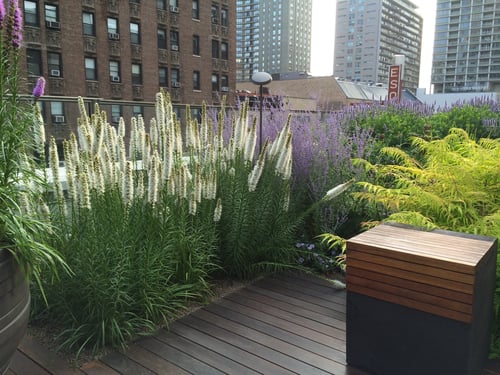In today’s bustling world, the green that used to pervade everyday human life sometimes gets lost.
Unless you’ve got a penthouse view of Central Park, you’re out of luck.
J/k. Lincoln Park counts too.
Still kidding, but the point stands: We humans often view our cities as gray spaces interrupted only by the occasional welcome patch of green, but that’s too simplistic.
 Ecology Is All Around Us
Ecology Is All Around Us
Ecology – a biological niche that describes the relationship between living organisms and their environments – exists all around us. While city hardscapes and zipping cars and high-rises may interrupt the habitats and patterns of wildlife, they do not cancel it out.
Life survives right here in our cities.
Our responsibility as a species is to ensure that life not only survives, it thrives. Healthy urban ecology means building cities and structures that merge with the life within and around them, rather than relegating that life to the countryside and hoping for the best.
Problem is, a lot of people just don’t know what that looks like. And while they want to do better by birds, pollinators, native plants and other species, they don’t know how.
We can change that, but not without a deep understanding of what a healthy urban ecology looks like.
What Exactly Is Urban Ecology?
 According to the British Ecological Society, ecology is a varied subject. It encompasses the study of organisms, their locations and numbers, the interactions between them, the interactions between them and their environment, and the complex architecture of various ecosystems as a whole.
According to the British Ecological Society, ecology is a varied subject. It encompasses the study of organisms, their locations and numbers, the interactions between them, the interactions between them and their environment, and the complex architecture of various ecosystems as a whole.
It is not a far leap to see how this translates to urban spaces. In this context, we’re talking about organisms suited to living within cities – given the space and the proper welcome – as well as how those organisms interact with both us and other wildlife.
Urban ecology refers more broadly to the structure of the metropolitan environment: its horizontal and vertical surfaces, its green spaces, its food and water supplies. (Food and water for plants and animals, that is, rather than us.)
Ultimately, fostering a healthy urban ecology means learning what makes it healthy and sustainable and what we can do, day by day, to keep it so. It also means understanding who wants to live within our cities as well as how those cities currently fail to serve such species.
Why Do Urban Environments Degrade Ecological Spaces?
The above, in turn, requires an understanding of how cities degrade ecological spaces.
You don’t need a degree in rocket science (or civil engineering) to see why previous habitats get displaced by the building and expansion of a village, town, city or major metropolitan area. Any time we disrupt the ecosphere – the sum environment of all the Earth – on a scale large or small, we cause distress to the plants and animals living there.
Specifically, in cities, this means:
- Stormwater runoff, which causes sewer overflows and poisons natural waterways
- Erosion from deforestation, soil depletion and runoff
- Pollution
- Reduction or elimination of natural habitat
- Homogenization of species and monoculture
- Takeovers by non-native species
- Bird strikes on buildings
Most of us frown and sigh and wonder what to do … then go get another chai latte, because really, what are we supposed to do against the magnitude of today’s disrupted wild ecology?
Good news: We’re not getting it all wrong. In fact, some companies are getting it very, very right.
Ongoing Advancements: What We’re Doing Right

We live with the assumption that “cities are bad! countryside is good!” but that’s a pretty broad brush with which to paint all urban spaces (and all wild ones, for that matter).
Despite the above drawbacks to cities, which are admittedly extreme, there’s no law saying that areas of dense urban population must necessarily suck for animals. We can make our urban spaces both sustainable and welcoming, if we try.
For instance, urban parks often provide a welcome respite for birds on migratory routes, or habitat for native squirrels. Native gardening initiatives help ensure that native pollinators such as flies and wild bees have food.
Lights Out campaigns are quickly spreading across the nation. They encourage cities to turn out the lights in office buildings at nighttime so that nocturnal migratory birds don’t see them and run into the windows. The program has seen quite a bit of success already.
But some of the most powerful results we’ve seen, if not the most powerful, lie in creating green spaces far above the city floor. Green roofs capture stormwater, purify it, reduce energy consumption in buildings (and therefore pollution), provide animals with new habitat, and generally rock. They also increase species variety and reduce monoculture in cities, and broaden the range of plant and animal habitats.
They are not the only systems helping us create a healthy urban ecology, but they’re certainly pulling their weight – and then some.
How Can You Help Promote Healthy Urban Ecology?
So what can you do to improve urban ecology in your local city, right here in the Midwest?
Simple: Take a look around. Check out urban ecology programs, and join in where you can. Note which spaces have no green things on them, and decide to put some there. Choose the right lighting for nocturnal animals. Do it yourself, if you have the expertise – and get some help if you don’t.
If you’re in the “don’t” category, we would love to partner with you. Green and growing things are our jam, especially when they’re three hundred feet up. If you’re looking for a dope new space, we’re here to help you find it … so get in touch today.

